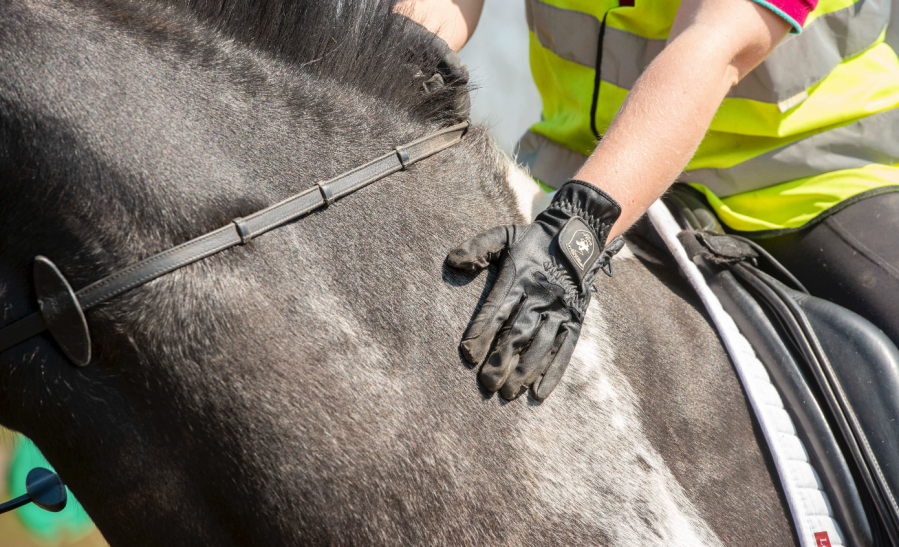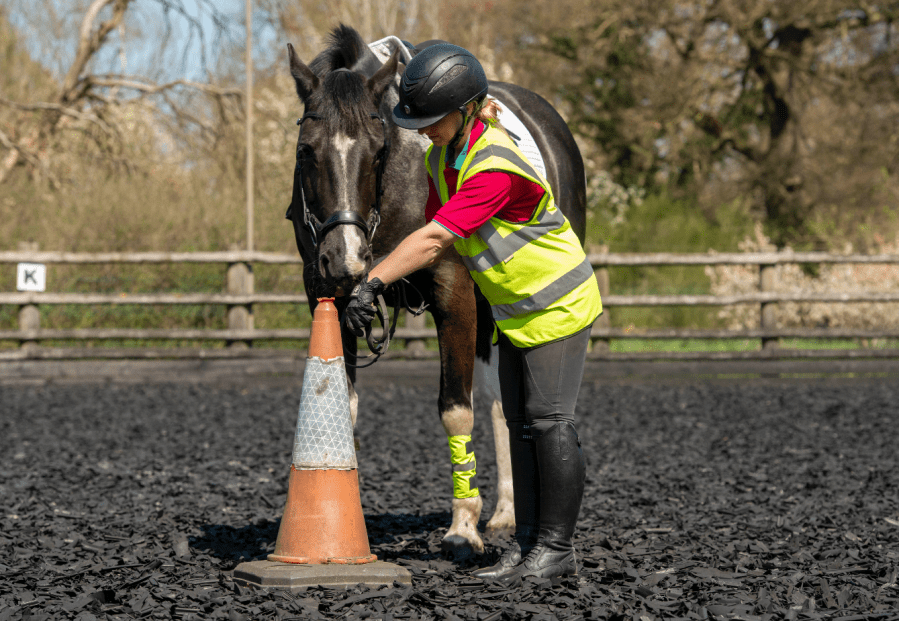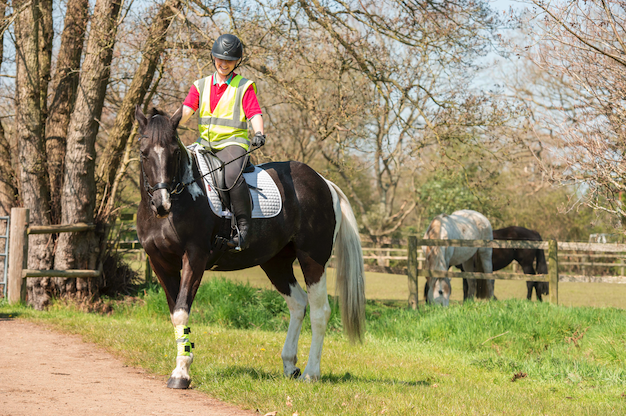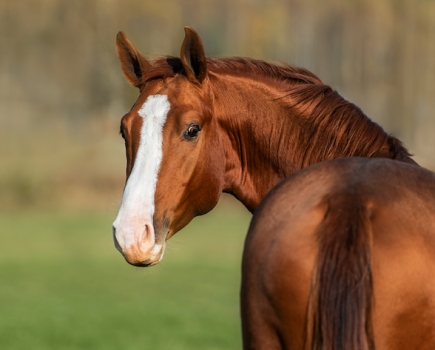When a horse is napping, they are trying to tell you something — and it’s usually “NO!”. This sort of behaviour happens when we ignore or are not aware of the smaller gestures horses use to tell us they do not feel secure or comfortable enough to go forwards.
Signs could include showing hesitation, slowing down, turning their head sideways to get a better look or smell of something, and snorting and spooking. We may also experience tail swishing, evasive manoeuvres, head tossing, tension throughout the body, and bucking and rearing.
Horses have a wide repertoire of behaviours and will express these louder and louder to tell us they are not comfortable. If we do not listen and try to force them forwards, we are likely to cause napping.
It’s very important to rule out pain and discomfort when dealing with any behavioural issue such as napping.
Finding a cause
A napping horse can be scary and dangerous for you as a rider, but with time and patience, this behaviour can be safely overcome.
When trying to get to the root of the cause, it is important to make the following checks first:
- Make sure your horse isn’t in pain. Ask your vet to investigate possible reasons for napping.
- Saddle fitters can check and make adjustments to your saddle to prevent pain from a poorly-fitting saddle.
- An equine dental technician, or a vet, can check your horse’s teeth and make sure the mouth isn’t the cause of any pain.
- Physiotherapists can work under referral from your vet to help where a horse has musculoskeletal issues and pain from tense muscles. They can develop training plans to build muscles more evenly if your horse is asymmetrical, has a tendency to go better on one rein, or may be compensating for injury or pain by moving unevenly. Often these issues are very subtle and hard for the untrained eye to detect.
When you have eliminated pain as being the cause, the next step is to consider that your horse’s napping could be a training issue.
How to handle a napping horse
“Horses who nap frequently and are successful in getting back to their comfort zone will learn that this behaviour works and this means they are likely to do it again,” explains Rosa Verwijs, a certified equine behaviour consultant with the International Association of Animal Behaviour Consultants and who is registered with the Animal Behaviour and Training Council.
“If when they nap again you are ready and try not to let them succeed, they are likely to increase the intensity and severity of this behaviour, which becomes a dangerous situation for all involved.
“If you use punishment (anything that causes pain or discomfort, such as pulling on the reins, kicking and using the whip) you are likely to increase the anxiety levels your horse is feeling and make the behaviour worse.
“Instead, we need to find out the cause of the napping and deal with that problem.”
Predicting discomfort
Horses predict discomfort and anxiety so will want to avoid this, and that’s where we see horses that nap.
They learn from previous experiences to avoid situations that could potentially be harmful.
“Many horses will nap because they do not want to leave their friends. Having equine company is really important to horses, and we often don’t realise how crucial this need is,” adds Rosa.
“If your horse is happy to hack out in company or go to the field with other horses, but starts napping when on their own, this is the likely cause of that behaviour.”
The same is likely to happen in any situation in which you try to take them away from their friends, such as leading in from the field, taking them away from the stables, going towards the arena, wash bays, or any other area where they know they will be on their own.
Horses are very quick to learn when this will happen, and will nap to avoid doing so.
This may be accompanied by high pitched whinnies as they try to locate their friends once they can no longer see them.
Top tips to solve napping
When you are confident that pain is not a cause of napping, there are different approaches you can take depending on the cause of the napping.
It’s vital to identify the cause in order to be able to apply the best method of modifying that behaviour.
Horses that nap due to pain and have the pain resolved may still nap because they still anticipate pain.
We need to go slowly and allow them time to realise that there is no pain anymore.
“Reassuring a fearful horse will build their trust in you, so if you feel the tension levels starting to rise, stop and allow your horse to process the situation, scratch them at the withers to reduce heart rate and encourage them to relax, and then when they are calmer encourage them to move forwards again,” advises Rosa.
“A great way to let a horse know they are doing the right thing is to give them food for doing so. That reward will become more important for them to focus on than whatever may be causing them to nap.
“This will gradually desensitise them to stressors, build a better relationship with you and help them to cope with other potentially stressful situations.”

Leaving other horses
We can also use this technique for horses that nap when leaving other horses.
We can separate them for short periods of time, and use distractions in the form of:
- Food
- Enrichment items and reassurance in the form of scratches and grooming.
Positive activities such as these teach the horse that although they are being separated, good things will happen.
“It’s important to increase the time separated gradually (think seconds, then minutes, then longer periods) so they know that they will get to see their friends again,” says Rosa.
“Out hacking you can practice short separations by allowing other horses to go short distances ahead and then waiting to catch up, and allow you to walk past a short distance and take it in turns.
“Be careful to increase these distances slowly, otherwise your horse will become too anxious and start to nap again.
“You can start this with short hacks in-hand, using food rewards and wither scratches when your horse stays relaxed.
“Then move on to doing this while riding, continuing with the scratches and rewards.
“This will build confidence and should help your horse to feel more secure about staying behind and taking the lead.”
A combination of causes
Sometimes napping is caused by a combination of smaller stressors that build up, the term for which is ‘trigger stacking’, which pushes your horse to a place where they cannot cope.
“Usually your horse can cope with these stressors individually, but if it’s windy, and there are a lot of cars going by too fast, you pull on the reins a little too hard and then tap your horse with the whip because they are not listening, the cumulative effect of all of these factors can be too much for your horse to cope with,” explains Rosa.
“For them, napping is now the behaviour you are likely to listen to, and return them to a place of safety.”
Common causes of napping
As well as pain, horses can become fearful of some situations and begin napping due to the following:
Expecting too much from the horse
Perhaps the horse is young, inexperienced, unfit or in their older years. Don’t over-face them; if you do, you risk them saying “no” by napping.
Punishing
Avoid using punishment to correct inappropriate behaviours. This might be shouting at the horse or hitting them with a whip, for example.
Rider lacks confidence
A lack of confidence in a rider can cause a tense riding situation. Your horse looks to you to be the leader and takes confidence from that, so if you find a situation scary, chances are they will too.
Fear of other horses
Feeling fearful of other horses when working in the same area, such as a busy collecting ring or during a group lesson, can be a problem for some horses (and riders).
Hacking nerves
Fear of traffic, ‘hedge monsters’, farm animals in fields (especially ones horses can smell and/or hear but can’t see), drain covers on the road, for example.
Dominant horses
Other horses that bully them in the field (or even in the yard — for example a horse will be reluctant to walk past the stable of a horse who routinely reaches out to bite them).
Case study: finding the cause
Understanding the cause of why your horse is napping is the first stage of working through it. Seek help from an expert or trainer if you need to, before the situation becomes out of hand and you and your horse start to lose confidence and trust in each other.
When 10-year-old gelding Paddy suddenly started freezing on the driveway out of his yard, rearing and spinning if pushed by his rider, his owner decided she needed help.
They hadn’t managed to hack out in weeks, and the horse’s napping behaviour had become dangerous.
Paddy’s napping began when, on his last hack out, rubbish had been left at the yard entrance. As he came through the gates the wind blew the rubbish and he and some of the other horses spooked and bolted back to the yard.
Step 1: Desensitising
“To help Paddy overcome his napping, I began by working on desensitising him to rubbish bags and moving rubbish by staying at a distance and waiting for him to relax before decreasing the distance.
“His owner stayed with him and gave him scratches and food rewards to reassure him,” explains Rosa.
“Over time, I could get close and he began to investigate the plastic bags without showing fear.”
Step 2: Target training
Now that his fear of the rubbish bags was something he could control, Rosa moved on to using a target to train Paddy to move more confidently down the driveway.
“We used a traffic cone, and began by waiting for him to investigate it with his nose in the familiar environment of the stable yard where he was most relaxed,” she says.
“As soon as he touched the cone, he got a treat. He quickly learned the new “touch the target, get a treat” game.
“We then moved the target and cued him to touch it by saying ‘target’ just before he did so, making sure he got a treat every time he touched it.”

Step 3: Make it fun
Then they moved to the arena, where Paddy was loose, and played some simple movement games using the target. This progressed to moving around other areas of the yard on a loose lead rope, and eventually the driveway.
“He was then ridden towards the target and was offered the treat from the saddle, by asking him to stand and bend his head around to a lowered hand holding the treat near his shoulder,” says Rosa.
“The target was used to increase distances and now Paddy stays at the end of the drive and walks calmly down the drive, touches the target and then confidently continues out on his hack.”
All images © Your Horse Library/Kelsey Media Ltd/Lucy Merrell








